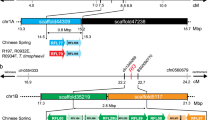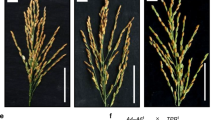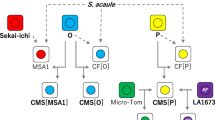Abstract
Plant cytoplasmic male sterility (CMS) results from incompatibilities between the organellar and nuclear genomes and prevents self pollination, enabling hybrid crop breeding to increase yields1,2,3,4,5,6. The Wild Abortive CMS (CMS-WA) has been exploited in the majority of 'three-line' hybrid rice production since the 1970s, but the molecular basis of this trait remains unknown. Here we report that a new mitochondrial gene, WA352, which originated recently in wild rice, confers CMS-WA because the protein it encodes interacts with the nuclear-encoded mitochondrial protein COX11. In CMS-WA lines, WA352 accumulates preferentially in the anther tapetum, thereby inhibiting COX11 function in peroxide metabolism and triggering premature tapetal programmed cell death and consequent pollen abortion. WA352-induced sterility can be suppressed by two restorer-of-fertility (Rf) genes, suggesting the existence of different mechanisms to counteract deleterious cytoplasmic factors. Thus, CMS-related cytoplasmic-nuclear incompatibility is driven by a detrimental interaction between a newly evolved mitochondrial gene and a conserved, essential nuclear gene.
This is a preview of subscription content, access via your institution
Access options
Subscribe to this journal
Receive 12 print issues and online access
$209.00 per year
only $17.42 per issue
Buy this article
- Purchase on Springer Link
- Instant access to full article PDF
Prices may be subject to local taxes which are calculated during checkout




Similar content being viewed by others
Accession codes
References
Laser, K. & Lersten, N. Anatomy and cytology of microsporogenesis in cytoplasmic male sterile angiosperms. Bot. Rev. 38, 425–454 (1972).
Schnable, P.S. & Wise, R.P. The molecular basis of cytoplasmic male sterility and fertility restoration. Trends Plant Sci. 3, 175–180 (1998).
Hanson, M.R. & Bentolila, S. Interactions of mitochondrial and nuclear genes that affect male gametophyte development. Plant Cell 16, S154–S169 (2004).
Chase, C.D. Cytoplasmic male sterility: a window to the world of plant mitochondrial-nuclear interactions. Trends Genet. 23, 81–90 (2007).
Woodson, J.D. & Chory, J. Coordination of gene expression between organellar and nuclear genomes. Nat. Rev. Genet. 9, 383–395 (2008).
Carlsson, J. & Glimelius, K. Cytoplasmic male-sterility and nuclear encoded fertility restoration. in Plant Mitochondria (ed. Kempken, F.) 469–491 (Springer, New York, 2011).
Lin, S. & Yuan, L. Hybrid rice breeding in China. in Innovative Approaches to Rice Breeding 35–51 (IRRI, Manila, 1980).
Virmani, S.S. Advances in hybrid rice research and development in the tropics. in Proceedings of the 4th International Symposium on Hybrid Rice (eds. Virmani, S.S., Mao, C.X. & Hardy, B.) 7–20 (IRRI, Manila, 2003).
Cheng, S.H., Zhuang, J.Y., Fan, Y.Y., Du, J.H. & Cao, L.Y. Progress in research and development on hybrid rice: a super-domesticate in China. Ann. Bot. (Lond.) 100, 959–966 (2007).
Bentolila, S., Alfonso, A.A. & Hanson, M.R. A pentatricopeptide repeat-containing gene restores fertility to cytoplasmic male-sterile plants. Proc. Natl. Acad. Sci. USA 99, 10887–10892 (2002).
Brown, G.G. et al. The radish Rfo restorer gene of Ogura cytoplasmic male sterility encodes a protein with multiple pentatricopeptide repeats. Plant J. 35, 262–272 (2003).
Wang, Z. et al. Cytoplasmic male sterility of rice with boro II cytoplasm is caused by a cytotoxic peptide and is restored by two related PPR motif genes via distinct modes of mRNA silencing. Plant Cell 18, 676–687 (2006).
Warmke, H.E. & Lee, S.L. Pollen abortion in T cytoplasmic male-sterile corn (Zea mays): a suggested mechanism. Science 200, 561–563 (1978).
Sabar, M., Gagliardi, D., Balk, J. & Leaver, C.J. ORFB is a subunit of F1F(O)-ATP synthase: insight into the basis of cytoplasmic male sterility in sunflower. EMBO Rep. 4, 381–386 (2003).
Levings, C.S. III. Thoughts on cytoplasmic male sterility in cms-T maize. Plant Cell 5, 1285–1290 (1993).
Balk, J. & Leaver, C.J. The PET1-CMS mitochondrial mutation in sunflower is associated with premature programmed cell death and cytochrome c release. Plant Cell 13, 1803–1818 (2001).
Guo, J. & Liu, Y.-G. The genetic and molecular basis of cytoplasmic male sterility and fertility restoration in rice. Chin. Sci. Bull. 54, 2404–2409 (2009).
Liu, Z., Xu, H., Guo, J. & Liu, Y.-G. Structural and expressional variations of the mitochondrial genome conferring the Wild Abortive type of cytoplasmic male sterility in rice. J. Integr. Plant Biol. 49, 908–914 (2007).
He, S., Abad, A.R., Gelvin, S.B. & Mackenzie, S.A. A cytoplasmic male sterility-associated mitochondrial protein causes pollen disruption in transgenic tobacco. Proc. Natl. Acad. Sci. USA 93, 11763–11768 (1996).
Zhang, Q. & Liu, Y.-G. Rice mitochondrial genes are transcribed by multiple promoters that are highly diverged. J. Integr. Plant Biol. 48, 1473–1477 (2006).
Zhang, G., Lu, Y., Bharaj, T.S., Virmani, S.S. & Huang, N. Mapping of the Rf-3 nuclear fertility-restoring gene for WA cytoplasmic male sterility in rice using RAPD and RFLP markers. Theor. Appl. Genet. 94, 27–33 (1997).
Zhang, Q.Y., Liu, Y.-G., Zhang, G. & Mei, M. Molecular mapping of the fertility restorer gene Rf-4 for WA cytoplasmic male sterility in rice. Yi Chuan Xue Bao 29, 1001–1004 (2002).
Delph, L.F., Touzet, P. & Bailey, M.F. Merging theory and mechanism in studies of gynodioecy. Trends Ecol. Evol. 22, 17–24 (2007).
Abad, A.R., Mehrtens, B.J. & Mackenzie, S.A. Specific expression in reproductive tissues and fate of a mitochondrial sterility-associated protein in cytoplasmic male-sterile bean. Plant Cell 7, 271–285 (1995).
Banting, G.S. & Glerum, D.M. Mutational analysis of the Saccharomyces cerevisiae cytochrome c oxidase assembly protein Cox11p. Eukaryot. Cell 5, 568–578 (2006).
Luo, H. et al. RTS, a rice anther-specific gene is required for male fertility and its promoter sequence directs tissue-specific gene expression in different plant species. Plant Mol. Biol. 62, 397–408 (2006).
Veniamin, S., Sawatzky, L.G., Banting, G.S. & Glerum, D.M. Characterization of the peroxide sensitivity of COX-deficient yeast strains reveals unexpected relationships between COX assembly proteins. Free Radic. Biol. Med. 51, 1589–1600 (2011).
Liu, X., Kim, C.N., Yang, J., Jemmerson, R. & Wang, X. Induction of apoptotic program in cell-free extracts: requirement for dATP and cytochrome c. Cell 86, 147–157 (1996).
Yao, N. et al. Mitochondrial oxidative burst involved in apoptotic response in oats. Plant J. 30, 567–579 (2002).
Greenberg, J.T. & Yao, N. The role and regulation of programmed cell death in plant–pathogen interactions. Cell Microbiol. 6, 201–211 (2004).
Diamond, M. & McCabe, P.F. Mitochondrial regulation of plant programmed cell death. in Plant Mitochondria: Advances in Plant Biology 1 (ed. Kempken, F.) 439–465 (Springer Science Business Media, 2011).
Papini, A., Mosti, S. & Brighigna, L. Programmed-cell-death events during tapetum development of angiosperms. Protoplasma 207, 213–221 (1999).
Hu, L. et al. Rice MADS3 regulates ROS homeostasis during late anther development. Plant Cell 23, 515–533 (2011).
Zhu, Q. & Ge, S. Phylogenetic relationships among A-genome species of the genus Oryza revealed by intron sequences of four nuclear genes. New Phytol. 167, 249–265 (2005).
Li, S. et al. Distribution of fertility-restorer genes for Wild-Abortive and Honglian CMS lines of rice in the AA genome species of genus Oryza. Ann. Bot. (Lond.) 96, 461–466 (2005).
Liu, Y.-G. Complementation of plant mutants with large genomic DNA fragments by a transformation-competent artificial chromosome vector accelerates positional cloning. Proc. Natl. Acad. Sci. USA 96, 6535–6540 (1999).
Walter, M. et al. Visualization of protein interactions in living plant cells using bimolecular fluorescence complementation. Plant J. 40, 428–438 (2004).
Hu, X. & Liu, Y.-G. The construction of RNAi vectors and the use for gene silencing in rice. Mol. Plant Breed. 4, 621–626 (2006).
Hiei, Y., Ohta, S., Komari, T. & Kumashiro, T. Efficient transformation of rice (Oryza sativa L.) mediated by Agrobacterium and sequence analysis of the boundaries of the T-DNA. Plant J. 6, 271–282 (1994).
Clough, S.J. & Bent, A.F. Floral dip: a simplified method for Agrobacterium-mediated transformation of Arabidopsis thaliana. Plant J. 16, 735–743 (1998).
Fan, L.M., Wang, Y.F., Wang, H. & Wu, W.H. In vitro Arabidopsis pollen germination and characterization of the inward potassium currents in Arabidopsis pollen grain protoplasts. J. Exp. Bot. 52, 1603–1614 (2001).
Chen, L. et al. The Hop/Sti1-Hsp90 chaperone complex facilitates the maturation and transport of a PAMP receptor in rice innate immunity. Cell Host Microbe 7, 185–196 (2010).
Li, N. et al. The rice tapetum degeneration retardation gene is required for tapetum degradation and anther development. Plant Cell 18, 2999–3014 (2006).
Acknowledgements
We thank G. Zhang, X. Liu (South China Agricultural University) and Q. Qian (China National Rice Research Institute) for providing some rice materials, H. Pang for technical assistance (GIBH, CAS) and H. Ma (Fudan University), J.-M. Li (University of Michigan) and Z.-H. He (San Francisco State University) for critical reading of the manuscript. This work was supported by grants (2011CB100203/2013CBA01401, 31230052 and 2013CB126900) from the Ministry of Science and Technology of China and the National Natural Science Foundation of China to Y.-G.L.
Author information
Authors and Affiliations
Contributions
D.L. performed most of the experiments involving the CMS gene functions and mechanism. H.X. and Z.L. found the CMS gene and analyzed its expression. J.G. investigated the gene origin. H.L., L.C., C.F., M.B., N.Y. and Hong Wu conducted cytological observations. Hao Wu and C.J. did plant transformation. Q.Z. mapped the mRNA ends. H.Z. mapped the interaction domains. Y.C., S.Y., X.L., X.Z. and R.L. participated in the characterization of the genes. Y.-G.L. designed and supervised the study and wrote the manuscript. All of the authors discussed the results and commented on the manuscript.
Corresponding author
Ethics declarations
Competing interests
The authors declare no competing financial interests.
Supplementary information
Supplementary Text and Figures
Supplementary Figures 1–13 and Supplementary Tables 1–4 (PDF 1241 kb)
Rights and permissions
About this article
Cite this article
Luo, D., Xu, H., Liu, Z. et al. A detrimental mitochondrial-nuclear interaction causes cytoplasmic male sterility in rice. Nat Genet 45, 573–577 (2013). https://doi.org/10.1038/ng.2570
Received:
Accepted:
Published:
Issue Date:
DOI: https://doi.org/10.1038/ng.2570
This article is cited by
-
A Mitochondrial Localized Chaperone Regulator OsBAG6 Functions in Saline-Alkaline Stress Tolerance in Rice
Rice (2024)
-
Assembly and characterization of the complete mitochondrial genome of Ventilago leiocarpa
Plant Cell Reports (2024)
-
Identification of fertility restoration candidate genes from a restorer line R186 for Gossypium harknessii cytoplasmic male sterile cotton
BMC Plant Biology (2023)
-
Establishment and Advances of Third-Generation Hybrid Rice Technology: A Review
Rice (2023)
-
Substitution Mapping and Allelic Variations of the Domestication Genes from O. rufipogon and O. nivara
Rice (2023)



